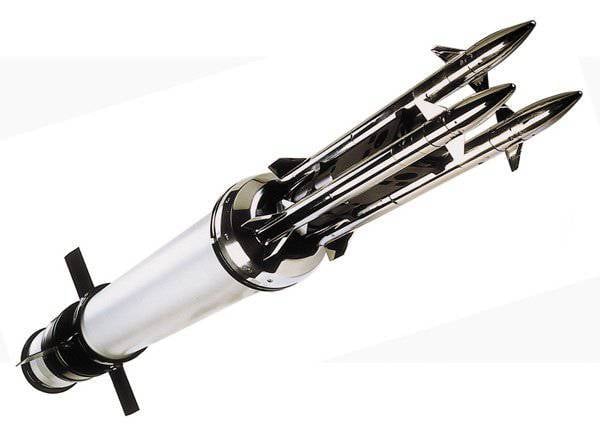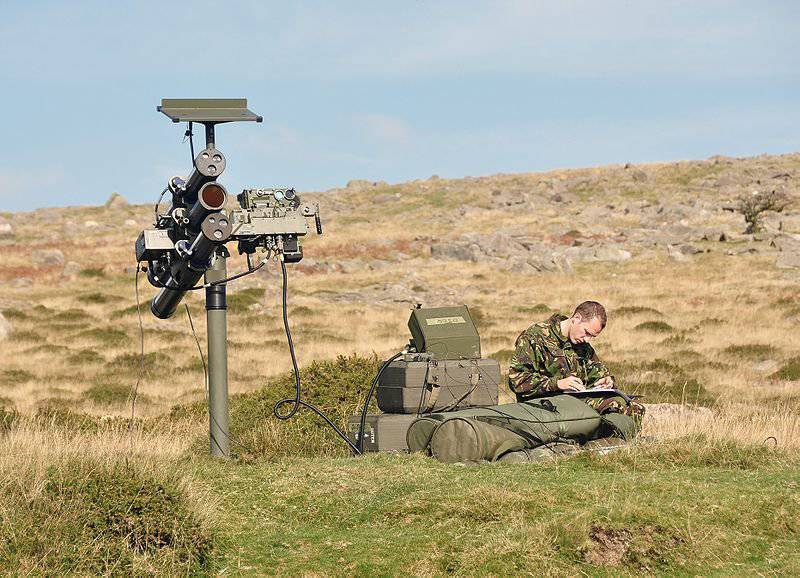Starstreak: air defense for the London Olympics

As it turned out, before the start of the May-month training exercises scheduled for the beginning of the month of May, the British military installed air defense systems right in London. An understandable and understandable step: terrorists can attack from the air, as it was in the notorious September 11 of 2001 of the year. However, the place for the deployment of air defense was selected very, very interesting. The position of the former water towers on the territory of the residential complex Bow Quarter was chosen. If we take into account the fact that this residential complex is considered one of the most elite in the city, then we can imagine the reaction of the inhabitants of seven and a half hundreds of its apartments. Nevertheless, the British Ministry of Defense reassures residents and claims that they are absolutely not in danger. The military department explains the choice of a place for anti-aircraft gunners simply and clearly: it is from the Bow Quarter water tower that the Olympic Park is best viewed. In the end, say the British military, after the end of the Olympics, all the rockets will be removed and life will go on as usual. Unless, of course, someone notices any changes in the usual way because of the presence of the military.
Continuing to reassure the residents of Bow Quarter, the military distributed leaflets around the residential complex, which explained in a simple and understandable manner who would do what and what to fear and what not. Among other things, the leaflets explain why, from the second to the tenth of May, soldiers will behave restlessly and even produce training missile targets. Also, the military promised to do without any launches. According to the results of these exercises, the Ministry of Defense will make a decision regarding the further fate of the post on the former water towers. If such an arrangement of anti-aircraft gunners really turns out to be convenient, then it will continue until mid-August. If not, a new place will be found soon.
The ten soldiers assigned to watch on water towers will have Starstreak man-portable air defense systems at their disposal. It is this anti-aircraft defense that was recognized as the most profitable and optimal for ensuring the protection of events and the city as a whole in terms of the ratio of combat characteristics and usability. The creation of Starstreak MANPADS, sometimes referred to as the Starstreak HVM (High Velosity Missile - High Speed Rocket), was launched in the first half of the eighties. Ordering the development of a new MANPADS, the British military pursued several goals at once: protecting motorized rifle units from air attacks, covering other objects, and universalizing anti-aircraft weapons of various bases. In turn, the developer of Starstrik, Thales Air Defense, conducted a series of analyzes and tests, during which the shape of the future portable air defense system was developed. TAD analysts and defense ministries found aircraft flying at near- or supersonic speeds, as well as attack helicopters, to be one of the main dangers for soldiers and vehicles on the battlefield. These air targets have rather different looks and characteristics, which, however, theoretically does not prevent the creation of a universal means of destruction for both. Universalism in terms of goals, as conceived by the designers, was to be ensured, first of all, by the high speed of the rocket. With its help, it was planned not only to reduce the time between launch and hit, but also to ensure the destruction / damage of the aerodynamic target before it enters the launch area of its weapons. In addition, the engineers of Thale Air Defense have developed a very original way to increase the probability of hitting the target, but about it a little later.

From the very beginning, Starstreak was designed as a universal complex that could be used in three maximally unified versions: “single-tube”, machine-mounted for three rockets and intended for installation on a vehicle (for installing 3-4 rockets). Transport and launch containers, missiles and guidance equipment should have been the same for all options. The chosen concept of the new MANPADS, almost unchanged, reached 1997, when Starstrik was adopted.
The basis and the main element of the entire portable air defense system - the HVM rocket. Of considerable interest is its design. The fact that the two-stage ammunition has a very original layout and warhead. So, to launch the rocket is equipped with a solid-fuel booster that ejects it from the WPK. Then, the first-stage solid-fuel propulsion engine turns on, which in a matter of seconds accelerates the rocket to a speed of about M = 3. Upon reaching this speed, the shooting of the second stage, which is the combat unit. An interesting fact is that this is not a stage in the classical sense. Warhead Starstreak consists of three so-called. darts. Each dart 45 centimeters long is equipped with its own warhead (armor-piercing core and high-explosive fragmentation charge), as well as its own guidance system.
Before using Starstreak, a removable control unit is installed on the TPK, which has an optical sight, a laser system, a computer and a power supply unit. The anti-aircraft gunner when firing from MANPADS uses a trigger mechanism, a pointing joystick and a number of other controls, such as switches for a side wind compensator or a device for calculating the rocket’s altitude profile. Immediately before launching, the anti-aircraft gunner turns on the complex and performs preliminary aiming with the help of optical aiming devices. At this time, the automatics captures the target and begins to illuminate it with a laser. By pressing the trigger, the electric igniter initiates the launch accelerator and the rocket takes off from the launch tube. During this outburst, the rocket acquires a rotation, thanks to which four stabilizers-rudders unfold in the back of the rocket. It takes about two tenths of a second to burn the accelerator charge, after which it is separated. Then, when the rocket flies to a safe distance from the gunner, the first-stage engine turns on. The first stage accelerates the rocket to speeds three times the speed of sound and also fires off. After this, an approximate guidance by means of the second stage occurs and the “darts” are reset. In the tail part of the striking elements there is a receiver of laser radiation coming from the aiming block of the ground part of the complex. According to the available information, the guidance takes place with the help of two laser diodes, one of which creates a “floating” horizontal beam, and the other swings in a vertical plane. Processing the received information about the relative position of the laser "fans", the calculator of the striking element generates commands for the steering gears. Own engine "darts" do not have that does not interfere with them throughout the flight reliably guided to the targets, maneuvering with overload up to nine units. Starting from pressing the trigger to the very defeat of the target, the operator of the complex must hold an aiming mark on it. This is done by moving the ground part of MANPADS and a special joystick located on the guidance unit. According to the available information, a new version of electronics for Starstrik will be created soon, which will allow tracking the target automatically.
The very defeat of the target, as well as combat elements, is also of particular interest. The significant speed with which the "darts" fly, leads to the fact that perceptible damage to the aircraft is possible even without detonation of the charge - only due to kinetic energy. At the same time, there is a contact fuse. Its task is to detonate the charge after penetration into the target structure. The lack of a contact fuse, which is expressed in the need to hit the target, is compensated by the number of homing damage elements. It is noteworthy that in the manual for the use of Starstreak MANPADS it is allowed to use this complex against armored vehicles. Thus, the protection of lightly armored armored personnel carriers or infantry fighting vehicles with high probability will not withstand the impact of high-speed "dart", and in the case of a more serious enemy, armor protection may be penetrated to a small depth with subsequent undermining of the charge. Thus, the striking element of MANPADS in its action becomes similar to the projectile on the Hopkinson effect: exploding, the charge "knocks out" from the inner side of the armor fragments that hit the crew and internal equipment.
After the shot, the fiberglass transport and launch container is disconnected from the guidance equipment unit and sent for recycling or reloading. According to reports, one TPK can be used up to five times. In turn, the hardware unit is mounted on a new TPK with a rocket. It takes only a few minutes to prepare to use the rocket taken from the factory package, and this time is more dependent on the training of the fighter.
Transport-launch containers and sighting blocks of the Starstreak complex can be used in three versions:
- Portable air defense system with one missile. The aim block plus TPK with a rocket. Due to the relatively small mass (about 15 kilogram), the complex is designed for firing from the shoulder;
- easel installation. Three TPKs are mounted on one machine (either in one row vertically, or by a triangle) and the aiming block. The machine with missiles and the sighting unit can rotate 360 ° horizontally and has a vertical pickup angle of the order of 75-80 °;
- mounted installation. In general, similar to the previous version, but does not have a tripod. Intends for installation on cars, armored vehicles and watercrafts.
It is worth noting that the choice of Starstreak for the defense of Olympic London from the threats of terrorists has sufficient grounds. The fact is that this MANPADS is intended for hitting targets flying no more than a kilometer. Given the theoretical flight profile of the aircraft used in the hypothetical terrorist attack, this will be quite enough. Moreover, at a higher altitude, the “zone of responsibility” of other anti-aircraft missile systems, for example, Rapier, is already beginning. As for the range, the anti-aircraft gunners on the former water towers in the Bow Quarter residential complex can cover a large part of London’s square, and most importantly, the Olympic Stadium, and many other objects of the upcoming competitions, with the maximum possible range of seven kilometers of rockets. Moreover, from the available data it follows that such air defense positions will be created throughout the city. True, the question remains of the place where the wreckage of the downed aircraft fell. However, this is such a problem, where the two evils have to choose the lesser. Although, of course, it would be better for all the 19 days of the Olympics to remain for the anti-aircraft gunners just another duty without incident.
Based on:
http://www.pravda.ru/
http://www.thales-airdefence.com/
Vasilin N.Ya., Gurinovich A.L. Anti-aircraft missile systems. - Minsk: Popurri LLC, 2002

Information